The Pros & Cons of My History Lesson Redesign
A MiddleWeb Blog
Last November, I wrote here about the value of the self-reflection process in helping teachers realize that a lesson or unit needs to be scrapped because it has outlived its effectiveness.
A quick recap: After I realized that my own U.S. Constitution “bridge” lesson just wasn’t working anymore, I immediately wrote a draft of what I thought would work better. The plus side of taking this tack: my thoughts and impressions of what needed to be changed were very fresh then and very welcome when I began the actual revision this year. On the other hand, I had to wait a whole year to see if it would work. Read on to learn whether scrapping a time-worn lesson paid off.
The new lesson challenged students to engage
Prior to this year, I taught about different types of governments through an activity where students decided how to place governance-related images and photos on a spectrum, without teacher guidance or definitions.
It was a challenge, but generally do-able. However, as I discussed before, this lesson just wasn’t quite connecting any longer. So I changed it to be more open-ended, hands-on, and student-directed. What had been a whole group activity would now be jigsawed. Groups of students became “experts” about one type of government and then conveyed this knowledge to their peers.
As the time to teach the lesson came around this fall, I was looking forward to seeing what the students would do with this new design. But I was concerned about a few things. Namely, a lesson that used to take one 50-minute period would now stretch into at least two (and probably three) periods in order to work. I was also concerned about how accurately important information would be conveyed via the jigsaw method.
Here are some reflections on how the lesson rolled out.
Initial Explanation of the Assignment
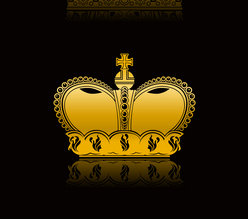
Facing an Open-Ended Assignment
We did this assignment early in the school year, so the students did not know me well yet. Some students were very excited about the prospect of an open-ended assignment and some were FREAKED out that they would not meet my expectations. They ask many questions about hypotheticals: What if we want to do ______? (my answer: yes). But what if we do_______? (yes), and so on. Is there a way to make it more clear to them that they can do anything they like as long as it addresses the assignment?
Clarifying the Assignment

Working on the Project
This was by far the most successful part. Students were engaged and really interested; they had access to Legos, a green screen, Tinkercad and a 3-D printer, and more.
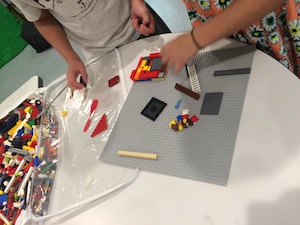
Otherwise, some groups would forget that they were building a country representing a government type and they would just focus on the details.
Presenting the Project
This was perhaps the most perplexing part about this lesson; how was I going to have the students present all these projects? As I mentioned above, time was a concern–I wanted to give each group due time to present without extending this already extended lesson much further. What I decided on was a rotating fair type model.
Students walked around and listened to/watched the demonstrations, presentations or movies of other groups/government types and took some basic notes. Presenters then switched with a teammate and went around themselves. It wasn’t perfect, but it seemed to give everyone a chance to see all the presentations in a timely fashion.
Synthesizing the Information
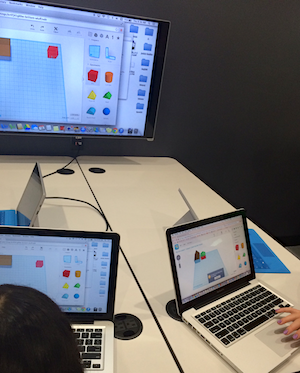
This went very well and was much less teacher directed than when I had done it in the past. Still though, I was nagged by the thought that while students were experts in their one particular government, I hadn’t done a great job assessing whether they could speak clearly about another type. Next year, I will need to add this –perhaps have them speak about other governments in comparison to the one they worked on in depth.
Assessing for Understanding

I also noticed that more students than usual had taken the option to write about a hybrid government, so perhaps the complexities and overlap between the government types came through.
After all this reflection, I realized that I needed also to justify this lesson’s existence. Do the students have to know what types of government exist to see the significance of the United States being a Democratic (mostly) Republic?
Is it imperative that they learn about other government types before diving into our Constitution unit? Currently I am holding at a “yes,” but I would love to hear your thoughts!
What lessons are you constantly shaping for your students?



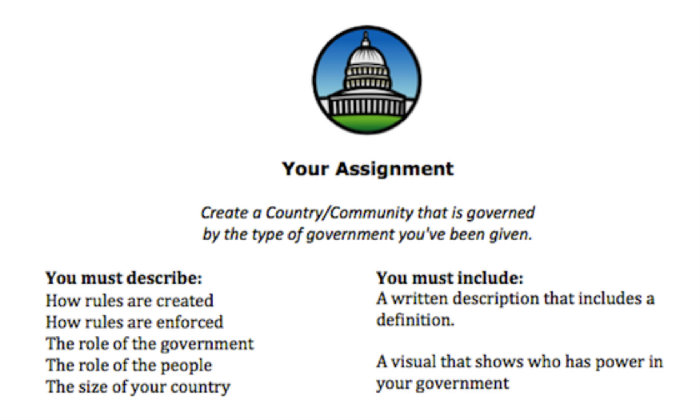
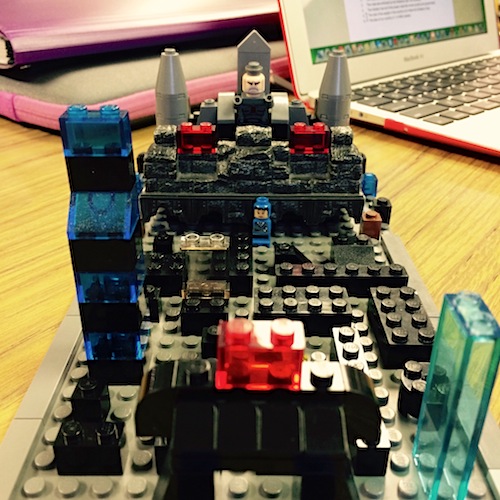


































Hi Jody,
I really loved this post and think it sounds like a great way to engage kids. I had an idea in response to your concern that kids didn’t know you well enough and were intimidated by the prospect of such an open-ended project. What if you were to model the activity by doing a presentation on the “government” of your classroom, using the exact same format you are asking of the kids. It would immediately give them an example and would also open you up a bit more to your class early in the school year.
As far as soliciting student buy-in, I wonder if there could be a short quiz they could take, something fun like all the Buzzfeed quizzes out there, that could help determine their group. Maybe there’s already one out there you could use, so you didn’t have to create one from scratch?
Thanks for the inspiring read!
Margaret
Just a thought but there is research out there that suggests any group work should not be done until about 6 weeks into the year after rules and procedures as well as rapport with students are all established. I know that takes some of the time you would want for the lesson but it might relieve some of the early year jitters doing a lesson like this.
Good ideas, Margaret. We recommend checking out resource guru Larry Ferlazzo’s evolving collection: The Best Sites for Creating Online Polls and Surveys. As a teacher who uses these tools in his own classroom, Larry is a great source.
Thank you so much for reading, Margaret, and for your awesome ideas. I love the idea of a Buzzfeed like quiz–the key would be to elicit questions of interest about, not of preference for government type. Great idea. I would love to hear more about your idea of modeling the government of the classroom–if you’re inclined, leave another comment, or email me at 21centuryteachr@gmail.com
Jody, I used to do a similar activity with my k-3rd grade students and we called it our Expert Report as well. I sent parents directions, a time line when portions of the project were due and a sign up schedule if they wanted to watch their own child’s presentation. Because these were very early entries into the world of research for primary students they were not graded by me and I explained this to parents. Their peers, however, did grade them a yes or no on these areas:
You spoke slowly and loudly enough for me to hear you.
I could tell that you had done a lot of research because you could answer so many questions we had.
You made good eye contact.
You followed the directions.
Finally they were required to sign their name and write one thing they had learned from the speaker.
In today’s world each child was given a choice of their own topic, how they wanted to present their learning and teach us.
Choices were:
an exhibit only along with an oral presentation to share their questions and answers with their peers.
A demonstration
A power point show
An activity to engage their friends in to help them learn
An idea of their own
They all had to create an exhibit [poster] with a title, their name, at least 5 curiosity questions about their topic and the answers, illustrations to help the audience understand their topic more completely.
Their presentation were spread out over about 4-5 days and many parents came to observe their own child.
The subject variety was quite wide and ranged from growing bamboo to how to tap dance, from a power point show on how jet engines work to what happens under water that causes a tsunami from one of my students who had been living in Japan with his family when the tsunami hit. That was the source of much laughter because it was a physical demonstration and I was invited to help. You can imagine who that tsunami hit!
I had the opportunity to judge at two regional History Day events and realized how this process was the foundation for a History Day research project for 6th – 12th graders. I still love looking at photos of the projects/exhibits from the spring of 2013.
Thank you for this post. I’ve read a couple of your posts and I find your reflections about your teaching to be helpful to me as a 7th grade SS teacher. I appreciate your wonderings and concerns about how to improve your lessons and how you will tweak what you do to make it better. I also appreciate how you are relinquishing control and giving it over to your students without making it a “free-for-all” activity. I look forward to future posts.
In thinking about outlining the government of your classroom, I was trying to think about how you could show the students a model of a government, but one that was different enough from governments around the world that it wouldn’t too much influence the way they developed their projects. Maybe it is something you could do with the school board. The board is elected, the board provides oversight directly to superintendents, who oversee principals, who oversee teachers, who are members of unions that represent them, etc. Students have a voice, so to speak, through SGA and through parents, who lobby for their children at PTA meetings and through their choices of whom they elect. (The trick, of course, would be avoiding any sticky spots relating to district politics, if that is an issue…) It seemed like if you could find a way to represent the governance of a school or classroom, it would be something that is close to home for students and then would give you the opportunity to have fun with the project and model for the kids that this is something they can really get creative with. Not sure if that is any more clear. Message me (margaretwoodwardhughes@gmail.com) if you want to knock ideas around!
Also, in thinking about the last question, whether it’s imperative to understand other governments before delving into the Constitution…what about swapping the two around. Doing the Constitution first, and then, to help them really understand what it’s trying to do, you have them study other countries. The idea then would be that students will have (hopefully) a good understanding of our form of government, and then they can better understand the other governments in relation to ours. This might in turn help with that question about whether they are really understanding the governments from other groups, not just the one they focused on.